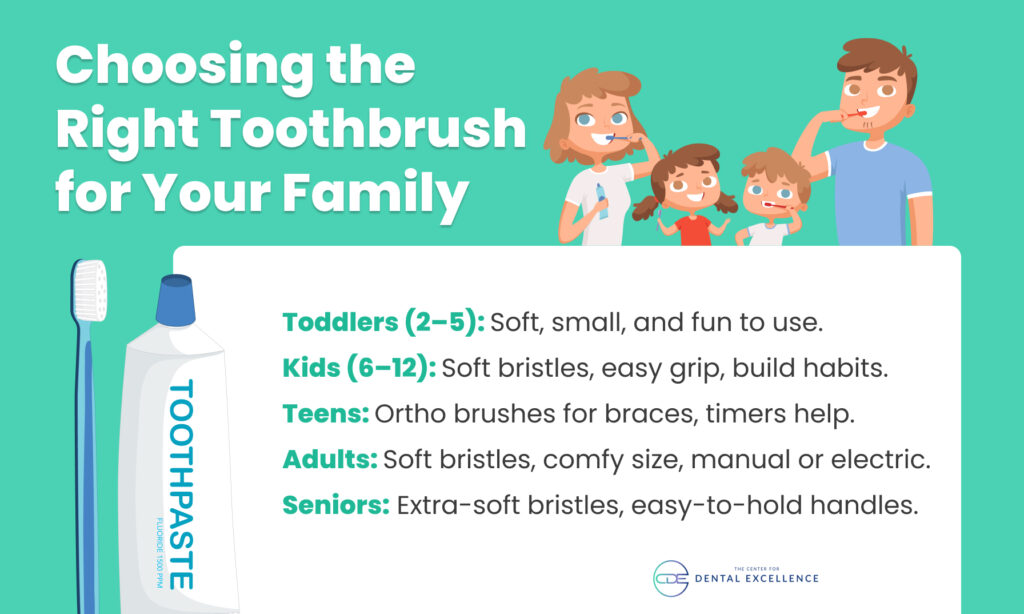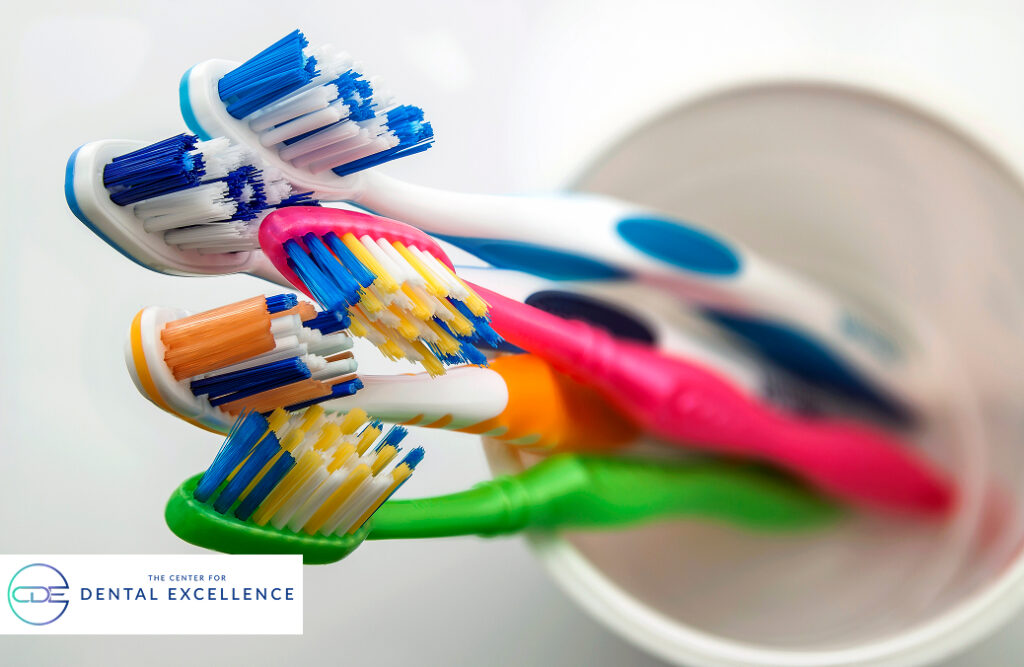Walking through the dental care aisle at the store can feel like a lot, right? You see so many toothbrush choices, and all of them say they are the best for your teeth. There are soft bristles, medium bristles, electric toothbrushes, and brushes for people of every age. With all these choices, how can you know which one is right for you and your family to help keep those smiles healthy?
The truth is, there is not one right toothbrush for everyone. A five-year-old will need one kind of toothbrush, but your teen needs another. What works for you may not work for your partner.
Let’s look at how you can pick the perfect toothbrush for each member of your family.

Why the Right Toothbrush Actually Matters
Before we get into the details, you may ask if choosing the right toothbrush really matters. The answer is yes, it does! The wrong toothbrush can leave your teeth less clean. It may also hurt your gums or wear down your tooth enamel over time. It’s like using the wrong brush to paint a house. Some paint will get on the walls, but it won’t look smooth or even. The same goes for brushing your teeth. A good brush makes a big difference.
Your toothbrush is the first thing you use to fight off plaque, bacteria, and tooth decay. If you pick the right toothbrush and use it the right way, you help your teeth and gums stay healthy for life.
Toothbrushes for Little Ones (Ages 2-5)
Young children need toothbrushes that feel soft and are the right size. They also should be fun so kids feel happy about regular brushing. At this age, you will still do most of the brushing for your child, so it is important for both of you to feel comfortable while brushing.
Look for toothbrushes that have small, rounded heads. These fit well in little mouths and are easy to use. The bristles need to be soft. This is important because a child’s tooth enamel is still growing and can get hurt if the bristles are too hard. Some parents think that soft bristles do not clean well. But, if you use the right brushing method, soft bristles clean just as well as hard bristles. They are also much safer for your child’s gentle gums.
Fun designs and bright colors are not only about marketing when it comes to kids’ toothbrushes. A toothbrush that has their loved cartoon character or is in a color they like can make the time to brush feel like fun instead of work. Brushing their teeth can feel like an adventure to them. Some toothbrushes for kids can even play music or light up for two minutes, which is the time they need to brush. These features help your child create good brushing habits early on.
School-Age Kids (Ages 6-12): Building Independence
As kids grow, their mouths get bigger. They also start to take more care of their own teeth. This time is very important for them to learn the right way to brush. Good brushing technique and healthy habits made now will stay with them for their whole life.
School-age children should use toothbrushes with a head slightly larger than those for toddlers. But these heads should still not be as large as the ones for adults. The bristles on the brush need to be soft. This is because children have teeth that are still coming in, and their gums are tender. A soft brush will be better for them. Try to get brushes that have easy, non-slip grips. This helps kids hold the brush on their own. A good grip makes it easier for them to clean their teeth every day.
This is a good time to let your child try electric toothbrushes if they want to. A lot of kids think the shaking feel and timers on these brushes are fun. Electric toothbrushes can also help make sure the child brushes for a full two minutes. But, a regular manual brush works just as well. The main thing is to make sure your child brushes their teeth often and does a good job each time.
Related Article: How to Help Your Kids Become Better Toothbrushers
Teenagers: Navigating Braces and Growing Independence
The teenage years are a time when life gets a lot more complicated, and that goes for taking care of teeth, too. A lot of teens have braces on during these years. They also start to feel freer with how they brush their teeth, but sometimes they are not very motivated to do it well every day.
If your teenager has braces, you need to think a bit more when buying a toothbrush. Orthodontic toothbrushes have a V-shaped bristle pattern. This shape helps clean around the brackets and wires better. The bristles on these toothbrushes are made to reach above and below the braces. This makes it a lot easier to clean their teeth well.
For teens who do not have braces, the best choice is a regular adult toothbrush with soft bristles. This is also the time when many young people like to use electric toothbrushes, and this can be a good thing. Electric toothbrushes are great for teens who might brush too fast. These brushes often have timers that help make sure they brush long enough.
Adult Toothbrush Selection: Finding Your Perfect Match
As an adult, you will find there are a lot of toothbrush options you can pick from. This can make it hard to know what to choose. The key is to know what your needs are and what is going on with your oral health.
For most adults, it is good to use a toothbrush with soft bristles and a medium-sized head. Many people think hard bristles or medium ones can clean better, but that is not true. Hard bristles may lead to gum recession and enamel wear as time goes on. When you use soft bristles with the right steps, they get plaque off well and are also gentle on your teeth and gums.
Think about the shape of your mouth when you pick a brush head. If you have a small mouth or it is hard to reach your back molars, a compact brush head can help. If your hands are bigger, try to find a toothbrush with a larger, comfortable grip.
People often talk about electric vs. manual brushes. Both can work well if used the right way. Electric toothbrushes have some good points. The timers on them help you brush for the right amount of time. They also move in a steady way, which can help get rid of plaque better than you might with a manual brush. But if you like using manual brushes and know how to use the right brushing style, you can stick with what you know. Both choices can be good for your teeth.
Special Considerations for Seniors
As people get older, their oral health needs to change too. This means the type of toothbrush they use should also change. Seniors may have arthritis, and this can make it hard for them to hold a regular toothbrush. Gum recession can also happen, and this needs more gentle care when brushing. Taking these things into account can help people take good care of their oral health as they get older.
If you have trouble using your hands, try to get toothbrushes with big, soft handles. These feel better to hold and are not hard to grip. Some toothbrushes are made with special handles that do not require you to move your hands in a careful way. Electric toothbrushes are also good for seniors. They clean well and do not need you to move your hand a lot for effective cleaning.
If you have sensitive gums or your tooth roots show because of gum recession, it is best to use toothbrushes with extra-soft bristles. Some toothbrush makers create special brushes for people with sensitive gums. These brushes have soft bristles that feel gentle on the gums but still do a good job of cleaning your teeth.

When to Replace Your Toothbrush
No matter which toothbrush you use, make sure to change it often. A toothbrush, even the best one, will not clean well if it is old. Replace your toothbrush every three to four months. If the bristles look worn or broken, get a new one sooner. After being sick, especially with something like a chest or throat infection, it’s good to start with a new toothbrush. This helps keep you healthy and stop germs from coming back.
Your Path to Better Oral Health Starts Here
Choosing the right toothbrush for every family member is simple. Look for soft bristles, a size that fits well, and something that helps you use it often. The best toothbrush is the one that you use every day with good habits.
Your family’s oral health matters. It is good to think about the choices you make for everyone at home. When you go for your next checkup, feel free to talk about toothbrush selection with your local dentist. If you want help for your family’s needs, they can give you advice just for you. Every small thing you do helps your dental health now and in the long run.